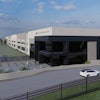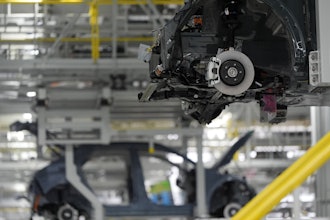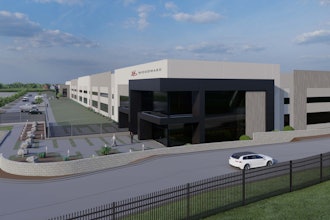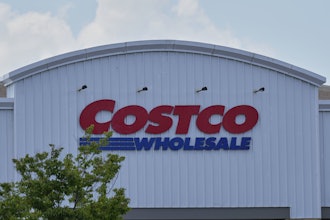Every doorway needs a door and at many distribution centers that is as far as consideration of the issue goes – sometimes to the peril of the operation. Dock doors provide a vital function on the dock wall and beyond to ensure the food safety, worker safety, energy efficiency and smooth traffic a facility needs to be profitable and to attract and retain customer accounts. Dock doors made for the rugged demands of the DC dock combat a number of operational issues that are unique to the low temperature environment.
Door panel swelling
In a cold storage facility, the mixture of cold temperatures, moisture and heavy forklift traffic is brutal on equipment, especially on the dock doors. For a cold storage DC, extreme temperature differentials between the outdoor heat and high humidity, and the chilled air generated by the facility, wrings out a tremendous amount of moisture that hangs in the atmosphere. The presence of moisture, aggravated by the day-to-day door damage leads to problems.
Pounding by forklifts can cause panels to crack and seams to open. The exposed insulation acts like a sponge, expanding the panel as it sucks up moisture. For a standard door that runs along its track on guide rollers the heavier, swollen panels make door operation difficult.
While the best practice is to keep the dock door shut between deliveries to prevent the escape of cold storage energy and the invasion of the humid outdoor air, dockworkers aren’t willing to risk their backs lifting these doors as they take on weight. However, leaving the doors open if only between deliveries taxes the DC’s chilled air system and poses a risk to product quality.
Even in the best-run facilities door damage occurs frequently. Forklifts either run into or back into panels. In most locations the panel and track damage can lead to expensive cooling costs coupled with additional repair costs.
This was the case at the Industrial Cold Storage docks, located in Jacksonville, FL. This facility has a total 253,000 square feet with a 170,000 sq ft freezer – a massive amount of space to keep at low temperature.
The problem came to a head as ICS management found that, because of the damage and water-soaked weight of the door, forklifts were being used to pry the doors open. The force of the forklift during the lift could wedge the door in its tracks, making the door inoperable and the dock doorway unavailable to truck traffic, leading to potential delivery back-ups.
Worse were the repairs. According to the DC Manager Darrin Warren, “Either outside contractors or our maintenance crew were constantly tending to door damage and it was running up costs. We found they were spending a lot of time on doors when we had other more important jobs around the facility.”
The facility switched to impactable dock doors and its twelve doorways are now always accessible. When impactable doors get hit, their guidance mechanism releases the panel from the guide track to prevent damage.
Even the panels have a slight flex to cut down on resistance. A quick tug on the door handles resets the panels back into the track and the unit is operational quickly. The maintenance crew can stay busy on up-keep and repairs in other parts of the facility. As a result of this design the panel does not crack, the seams stay in tact and the door panel does not absorb moisture; enabling the door to glide easily up and down.
Moisture
Moisture can attack a door, and combined with residue and by products from processed foods can result in a dangerous, slippery dock floor. If the door has regular steel hardware these components will deteriorate and need constant replacement. As this breakdown occurs, gaps can form between the door and the doorframe, inviting more moisture into the dock area and onto the floor.
Pet Poultry Products, Inc., a family owned company based in Bridgeville, DE dealt with this problem. Running double shifts, Pet Poultry ships several million pounds of chicken parts out to pet food processors across a multi-state area from its 71,000 square foot facility.
Yet the doors they were using did little to stop the moisture build up on the dock. According to owner Bob Hunzsberger, the corrosion at the Pet Poultry dock was literally “eating up the doors.”
Hunzinger points out that the doors they had installed originally lasted only three or four years. On this tight 50’ x 25’ dock, the drivers are fairly hard on the docks, with the vehicles bumping into them on a regular basis. However, the moisture was doing plenty of damage as well.
To combat the door deterioration, whenever a door gets knocked out of commission, Pet Poultry replaces it with impactable dock doors equipped with stainless steel hardware.
The door’s ultra high molecular weight (UHMW) track is made out of high-impact polyethylene rather than the standard sheet metal track and can withstand direct forklift impact. On standard doors the track suffers 95 percent of the forklift damage and even if not destroyed, can make door operation very difficult, discouraging the dock crew from closing the door between truck shipments. In addition, the plastic track does not conduct heat like standard tracks, which also helps prevent condensation.
Energy loss
An impactable door provides a full perimeter seal including the area along the floor, ensuring that a chilled dock stays at 35 degrees without overtaxing the compressors from energy loss. No energy loss also means no condensation on the floor, and no risk of employees slipping or losing control of a piece of equipment.
Continental Refrigerated Services (CRS) is a full service cold storage warehousing and transportation provider offering a one stop shop and delivery system to help companies reduce freight costs. Its two University Park buildings equate to a combined total floor space of 517,000 sq ft, with racking for 44,000 pallet positions. Fifteen million cubic feet of those facilities is cold storage, which can present particularly high operating costs due to energy loss as a result of dock door and track damage.
Impactable dock doors made especially for cold storage applications protect the 73 cold storage shipping and receiving docks against energy loss. The doors have 4” thick insulation to help maintain temperature in cold storage and perishable dock environments but are designed to stand up to the abuse of forklift traffic while still helping.
At all dock doorway positions CRS has installed vertical levelers. When these levelers are stored erect their steel platforms are regarded as a means of guarding the dock doors against forklift damage. The levelers, however, cannot protect the doors when they are open. If the door is not fully up, the forklift mast can clip the bottom panel, damage it and disrupt traffic flow.
According to Chuck Balija, the Director of Engineering for CRS, “we don’t have to work about our doors getting hit at any time because the impactable doors can be reset if hit, enabling traffic to flow normally.”
Managing a freezer DC means dealing with extremes, and with the price of energy going up when the temperatures go down any opening in the building can be extremely costly to the operation. So too is the impact on the facility’s ability to serve accounts if any one of the door doorways becomes inoperable. Smart dock door selection is the kind of insurance cold storage operations need to get product out to the customers while keeping the cold air in the building.


















